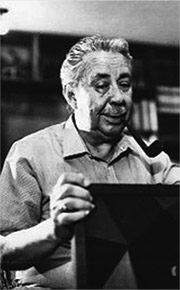Albano Neves e Sousa

Albano Neves e Sousa (1921, Matosinhos, Portugal - 1995, São Salvador, Brasil) was a portuguese-angolan painter, poet, writer and ethnographer. He was born in Portugal, living in Angola and, after 1975, in Brazil.[1]
Albano Neves e Sousa is a key figure in Angolan art history. His art provides a visual history of Angola, depicting its people and landscapes with remarkable passion.[2] His art is deeply connected to the culture of Angola and Brazil.
Neves e Sousa introduced the world to the Angolan martial art n'golo, which is considered the ancestor of capoeira.[3] His engolo drawings from 1950s have become an important historical document and one of the key proofs of the Angolan origin of capoeira.[3]
Biography
[edit]Albano Silvino Gama de Carvalho das Neves e Sousa was born on January 15, 1921, in Matosinhos, Portugal, during one of his family's trips to Portugal.[2]
Life in Angola
[edit]At a young age, he returned to Angola with his family, settling in Andulo in the province of Bié. He was sent to Luanda to attend high school, where he discovered his talent for painting.[2]
At the age of 15, Sousa held his first exhibition in Andulo in 1936, featuring watercolors, drawings, and caricatures. He spent most of his life in Angola, traveling extensively around the country, producing drawings and paintings inspired by its landscapes, people, and wildlife. In 1937, he held his first solo exhibition in Luanda.[2]
Sousa's career took a significant turn when he joined the ethnographic studies mission at the Museum of Angola while living in Luanda. This experience allowed him to explore Angola's diverse landscapes and cultures, influencing his artistic works.
In 1943, Sousa received a scholarship from the Luanda city council to study Fine Arts in Porto, Portugal. During this period, he collaborated with various art groups and won several awards.
Returning to Luanda in 1952, Sousa faced criticism from cultural media for his early exhibitions, which were seen as imitative of cubism. Nevertheless, he continued to evolve as an artist and gained recognition both locally and internationally. His career involved numerous exhibitions and travels to countries such as South Africa, Yugoslavia, Belgium, Brazil, Spain, Mozambique, Portugal, and more.[2]
About 1955, "n'golo dance" was first documented when Neves e Sousa visited Mucope, in Cunene Province.
In 1965, Albano Neves e Sousa, visited Mestre Pastinha's academy in Salvador, Brazil. He informed them of a dance in Angola similar to capoeira, called n'golo. After watching capoeira Angola at Pastinha's academy, he asserted that "N’golo is capoeira".[4] His testimony challenged the popular belief at the time that capoeira originated in Brazil, and highlighted the n'golo as an ancestral form of capoeira.[3]
Upon returning to Angola in 1966, Neves e Sousa organized an exhibition titled "Da minha África e do Brasil que eu vi" (From My Africa and the Brazil I Saw), highlighting cultural similarities between African and Afro-Brazilian expressions.[3]
Life in Brazil
[edit]In 1975, Sousa was commissioned to decorate an Angolan Boeing 737, which led him to travel to the United States. However, the Angolan Civil War started that year, and he moved to Brazil.
Sousa eventually settled in Salvador, Bahia, with his wife, Maria Luisa. There, he found inspiration in the local culture and landscapes. He also authored a book titled "Olohuma," reflecting his experiences in Bahia.[2]
His works continued to be influenced by the legacy of the transatlantic slave trade and the strong African cultural presence in Bahia. Sousa celebrated the similarities and connections between Bahia and Angola, particularly through his art's focus on landscapes, people, customs, and spirituality.[2]
